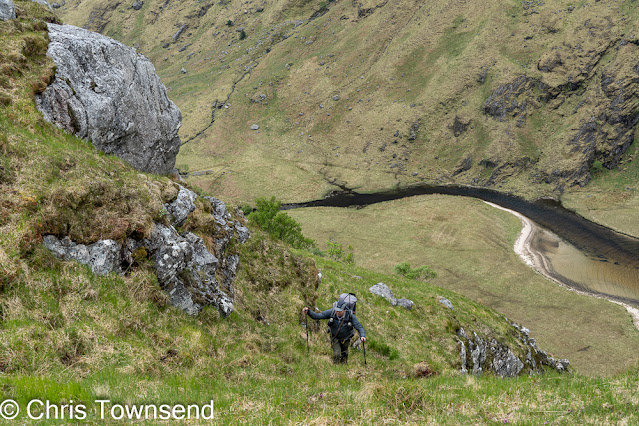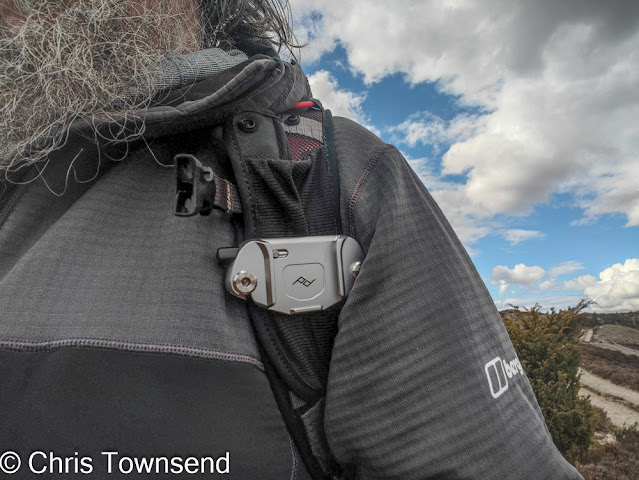 |
| Loch Morar from the ascent to Meall nan Each |
Rain and wind spattering and blowing against the tent woke me several times. It was the first night of a two-week trip in the wild of Knoydart in the Western Highlands, a place noted more for wet weather than sunshine, and also for the ruggedness of the terrain, hence being known as The Rough Bounds.
 |
| First camp: Glen Pean |
For the first five days I was with Tony Hobbs, on his first visit to the area, and his dog Lassie. We’d met in the afternoon at the end of the long rollercoaster road stretching from the Great Glen to the head of Loch Arkaig and walked for few hours along Glen Pean before camping beside the river. My plan was to walk through Glen Pean and descend Gleann an Obain Bhig then return to Loch Arkaig over 829-metre Carn Mor. Four days for this I thought, leaving a day for an ascent of 718-metre An Stac with light packs.
 |
| In the rain in Glen Pean |
By the end of the second day I’d realised we didn’t really have a spare day for An Stac and that idea was abandoned. The walk through Glen Pean, mostly in wind and rain, had proved quite arduous.
 |
| Kayak Man |
This is a wonderfully wild and dramatic glen but not that easy to traverse, though much easier for us than the man we met with a kayak on his head. He was portaging the kayak and a massive amount of gear from Loch Morar to Loch Arkaig and this was his fourth trip through the massive rockfall at the head of Glen Pean. We’d already passed two big bags of gear plus a trolley and a paddle and wondered about them. I reckoned they must belong to a group, though the paddle was puzzling. I hadn’t thought it would be just one person lugging all this stuff and a kayak through the mountains.
 |
| Tony finding a way through the rocks |
At least he wouldn’t have to lug everything up and down the narrow path that crosses steep slopes high above the crags that fall into little Lochan Leum an t-Saigairt, which we’d just done when we met him. There the kayak would be useful. Getting it through the rocks where Glen Pean narrows at its head must have been extremely difficult though. This tremendous place is a glorious confusion of massive boulders and crags and green with trees and moss, a tiny sliver of temperate rainforest. We found an intricate way through this tangle of vegetation and rock amazed that anyone could manage to transport a kayak here.
 |
| The view down to Loch Morar |
Once through the chaos there was a wonderful view down Gleann an Obain Bhig to Loch Morar. As we descended this glen the rain and wind eased and we set up camp not far from the loch in the dry.
 |
| Second camp: the sun starts to appear |
There was more rain overnight though and the next day came with low clouds, gusty winds, and showers. Not an ideal day for a steep climb to rocky summits but we decided to go anyway. The climb up onto the west ridge of Meall nan Each, which we had to cross to reach Carn Mor, was very steep, rising some 350 metres in less than a kilometre. The pathless terrain was very rough too, a mass of tussocks, bog, and rock. Hand and occasionally knees were used at times.
 |
| Tony on the ascent to Meall nan Each |
By the time the angle eased the wind was stronger and the cloud was not far above. After crossing Meall nan Each we spent a while searching for a reasonably sheltered site, eventually finding one at the head of a shallow gully just below the ridge. There wasn’t really room for either of our shelters but we managed to squeeze them in with just enough room to lie down. I reckoned it was better doing this than camping on more spacious but much more exposed sites a little higher up.
 |
| Third camp: somewhere on Meall nan Each |
The storm continued all night and into the next day. Heading for Carn Mor we were soon in the cloud and needed to keep a careful watch on our navigation as we threaded our way through the complex rocky and boggy terrain. The summit came and went in mist and rain – the views are probably excellent!
 |
| The storm starts to fade |
The roughness lessens beyond the summit and the going and navigation were both easier. A flash of rainbow below us marked the fading of the rain and cloud too and soon after we reached the edge of the forest in Glen Dessary the sun was coming out. Finding dryish and flattish spots to camp wasn’t easy and we ended up out of sight of each other.
 |
| Fourth camp: Glen Dessary |
The final day was just a stroll in the sunshine, mostly in the forest, back to our cars. Here Tony headed off on the long journey back south. I restocked my food supplies and swapped some items of gear then set off again, this time for a solo eight day walk. I’ll tell that story in my next post.

Enjoying the sun and airing damp gear at the Glen Dessary camp
Tony recorded a great deal of video during the walk,
including a chat with me about the gear I was using for his You Tube channel. That
chat and four other videos are already online and Tony says there will be two
more. Tony’s perspective on our trip is interesting!








